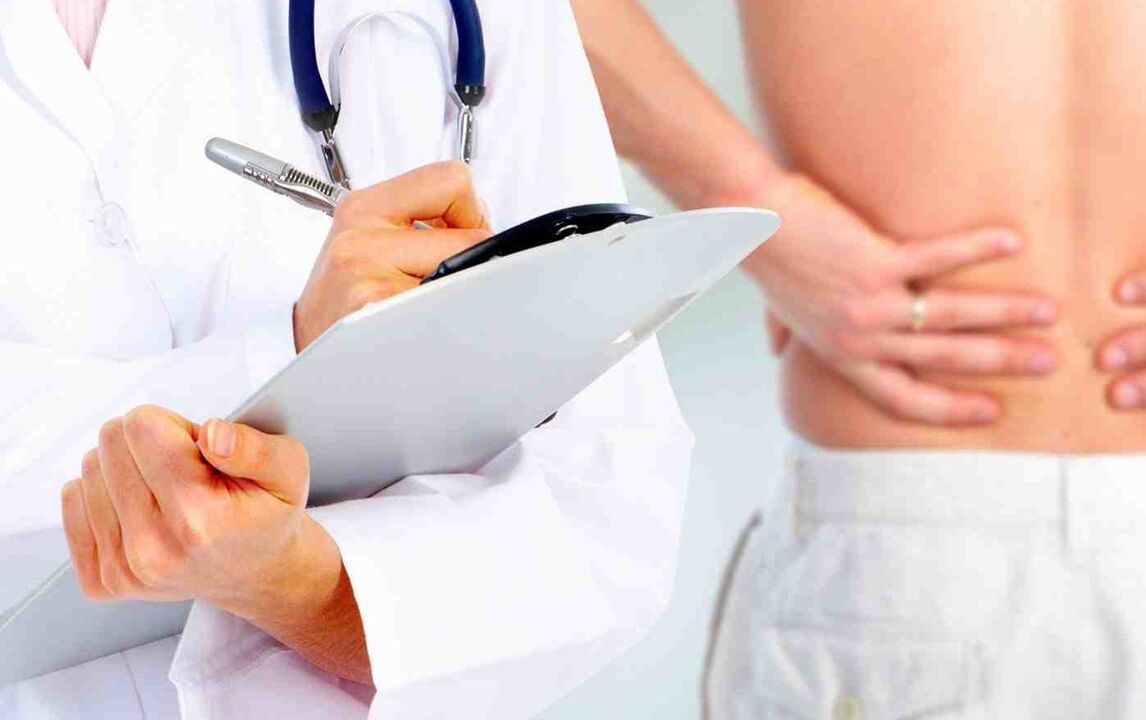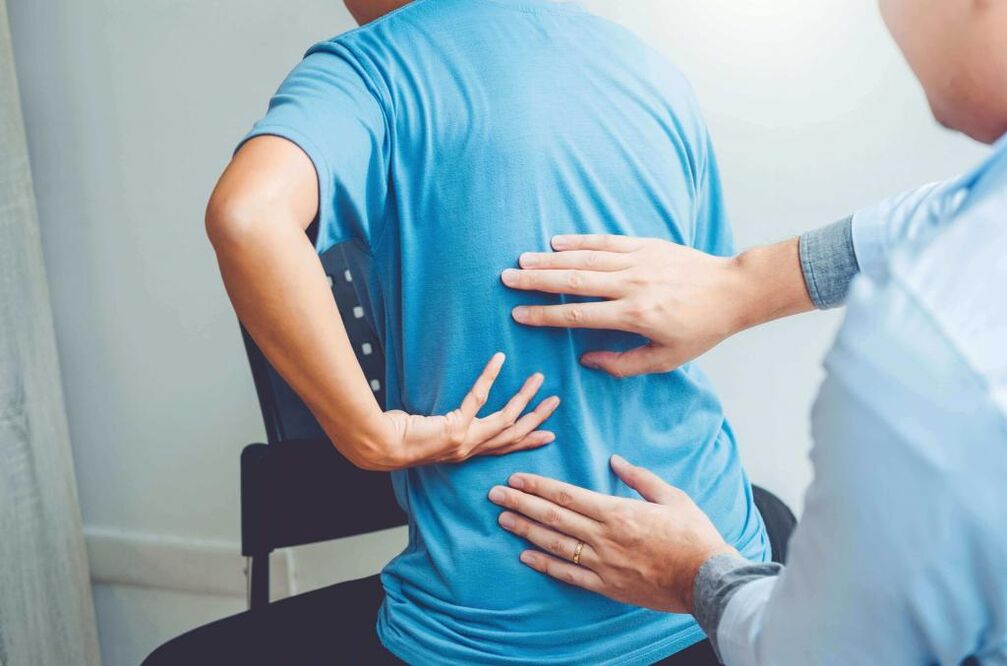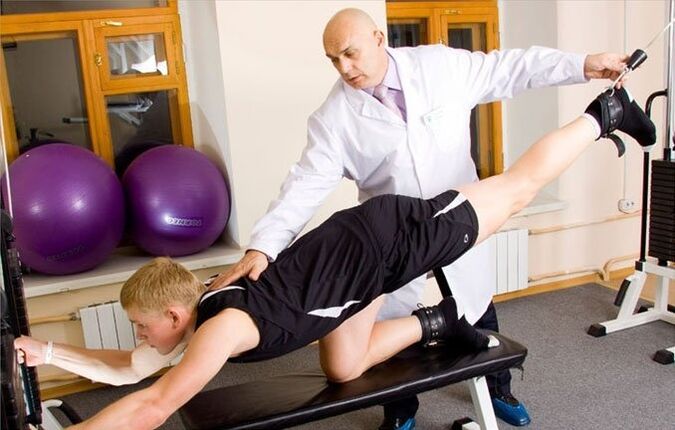So, let's consider in order the causes of pain syndrome that occurs in the lumbar region:
- Spine diseases. Rarer but more serious conditions that cause back pain include Bechterew's disease. With this disease, the vertebrae grow together, calcium is deposited in the ligaments, and the affected back loses mobility. Characteristic features of pain in this pathology: pain increases at rest, with a long lie; movements in the lumbar region are restricted. This disease most often begins at a young age and may have an inherited predisposition.
- Curvature of the spine. Kyphoscoliosis and asymmetric scoliosis (two types of curvature) cause spasm of the deep muscles of the spine. In most cases, the pain syndrome is felt in the middle and late stages of the disease, it manifests itself more acutely at the end of the day, along with fatigue. This pathology begins in childhood and can also have a hereditary predisposition.
- Osteoporosis is a decrease in bone mineral density, leading to bone fragility, frequent fractures.
- Osteochondrosis - thinning of the intervertebral discs, at a late stage leading to bulges and herniations of the intervertebral discs, the most common cause of back pain. Also, the pain intensifies when changing position: getting up from a sitting position, trying to lie on your stomach, turning over, bending over.
- Spinal cord injuries, sprains and bruises, fractures.
- Spondylolisthesis, that is, the displacement of the lumbar vertebra relative to the vertebra below it. The pain is located in the middle of the back, is felt along the legs, and is accompanied by numbness and/or weakness, which is aggravated by standing up or leaning back.
- Fibromyalgia is a pathology that causes pain in the muscles, ligaments and tendons. There is pain and stiffness in various parts of the body, the pain is aggravated by touching. Often the patient complains of lack of sleep. Most common in women ages 20 to 50.
- Soft tissue and kidney injuries. Severe, sharp pain from the diseased kidney is characteristic of urolithiasis. The pain can occur in any position of a person. Another disease that has discomfort in the lower back as a symptom is pyelonephritis.
- Infections or infections of the spine and spinal cord, eg osteomyelitis, discitis, spinal epidural abscess. The pain caused by this cause progresses, it does not depend on the position or activity of the patient. Sometimes there is a fever or night sweats.
- Local inflammatory processes, such as appendicitis or cholecystitis.
Low back pain is divided into three types: local, radiating and reflected. Local pain is felt in the same place as its cause, this type of pain is more common in lower back syndromes. In this case, the most common cause is osteochondrosis of the spine, degeneration of the intervertebral disc, stretching or spasm of the deep muscles of the spine.
The radiating pain is dull and aching, most often it radiates to the leg and happens to reach the foot. This may accompany osteochondrosis at the stage of disc herniation, osteoarthritis, or degeneration of the deep muscles of the spine with hemodynamic disturbances along the sciatic nerve.

Referred pain usually means that the cause of the syndrome is in the internal organs. For example, with heart disease, the arm, back, and shoulder blade may ache. The pain is reflected from the internal organs to the lower back and has a deep aching character, it does not depend on movements.
Lower back pain in men and women.
In women, back pain can be the result of gynecological diseases. In this case, the discomfort is dull, tight. Among such diseases in women, adnexitis, torsion of the ovarian cyst, salpingo-oophoritis, uterine fibroids and endometritis can be expressed as pain in the lower back. Pregnancy, due to the increased load on the spine and increased body weight, often leads to back pain, and they are also possible during menopause. With an ectopic pregnancy, back pain can also occur; in this case, it is unbearable.
The causes of low back pain in men are often caused by excessive exercise, heavy lifting, spinal injuries, but can also indicate exclusively male diseases: prostatitis or epididymitis. Pathology of the prostate is characterized by pulling and aching pain, the patient often has difficulty urinating.

Diagnosis and treatment of low back pain
Depending on the causes of back pain, different specialists are involved in its treatment. If it is a pathology of the spine, then you need to contact kinesitherapists, if it is a pathology of internal organs, then a therapist, gastroenterologist, gynecologist, urologist. If the pathology is of rheumatic origin, then to a rheumatologist, in cases of a neoplasm in the lower part of the body, then to an oncologist.
First of all, for diagnosis, the doctor interviews the patient, recognizing the nature of the pain: whether it is sharp or dull, whether it pulls, whether it depends on movement, activity, body position, whether it is accompanied by other symptoms. Or not. After verbal questioning, the doctor examines the patient, palpates the lumbar region, the muscles of the spine, and the extremities. Additional examination, laboratory tests, X-rays, MRI, tissue biopsy, electromyography may be required.
For treatment, also depending on the disease, various means are used. In cases of osteochondrosis, scoliosis, spondyloarthrosis and other factors that cause spasm and inflammation in the deep muscles of the spine, the most commonly used are analgesics and anti-inflammatories, but they do not directly affect the cause of the pain syndrome, they only eliminate its manifestation and it has many side effects. To address the cause of back pain, the following are suggested:
- power-type decompression exercises and stretching to relieve spasm of the deep muscles of the spine and eliminate pain,
- therapeutic massage to relieve tension in the muscles of the pathology area,
- cryotherapy to reduce pain locally,
- physiotherapeutic methods, such as shock wave therapy, acupuncture, massage with apparatus, balneotherapy (mud applications, contrast treatments, etc. ),
Back pain prevention
The main prevention of various diseases of the musculoskeletal system is the prevention of the development of dystrophy, that is, the weakening of the deep muscles of the spine, on the condition of which the nutrition of the vertebrae and intervertebral discs depends. Strengthening the muscles of the spine should be regular and the most modern way to do it is the author's method, that is, the use of power and decompression simulators. But exercises can also be performed without simulators, there are many of them. It is important to take a break for gymnastics at work, especially if it is a sedentary type, that is, every 3-4 hours, spend at least 15 minutes on this, just walk a couple of times a week for 1. 5-2 hours, and do it in the morning charging.

Depending on the method, it is recommended to regularly perform several simple exercises to prevent back pain:
- relaxation of the back (the well-known exercise "Cat"): in the position on all fours, inhale - raise your head, bend your back down; exhalation: lower your head, round your back;
- stretch step (in yoga, this exercise is called "Pigeon Pose") - in the all-fours position, you need to move one knee forward, foot in, and the other leg back, lie face down on your thigh , palms under your shoulders. For a more effective stretch, move your arms diagonally to your sides and lower your head, pausing for 5 to 10 seconds. Return to the starting position and repeat for the other side.
- raise the pelvis in a supine position with the legs bent at the knees;
- press: in a supine position, bend your knees and arms at the elbows, holding the back of your head, press your chin to your chest while exhaling, lifting your shoulder blades;
- Kneeling Press: In a prone position, pull your knees toward your chest, pressing your hands against your body as you exhale, or do so while hanging.
All these exercises are very simple, just do 10-15 repetitions of each exercise. With regular practice, they will bring you invaluable benefits!
Of the additional tips, a comfortable mattress can be placed so that the back muscles can relax at night. If you spend a lot of time driving or working on a computer, take care of the correct body position. The car seat should be height-adjustable and close to the steering wheel, and the backrest should be soft enough to contain bumps on rough roads.
While working or studying at the table, the elbows should be bent at a right angle. The chair must necessarily have a back to support the lower back, and the gaze (along with it and the neck) should be directed up or slightly up, but not down. The light falls correctly on the work surface of the table.
Remember, prevention is more important than cure!



























